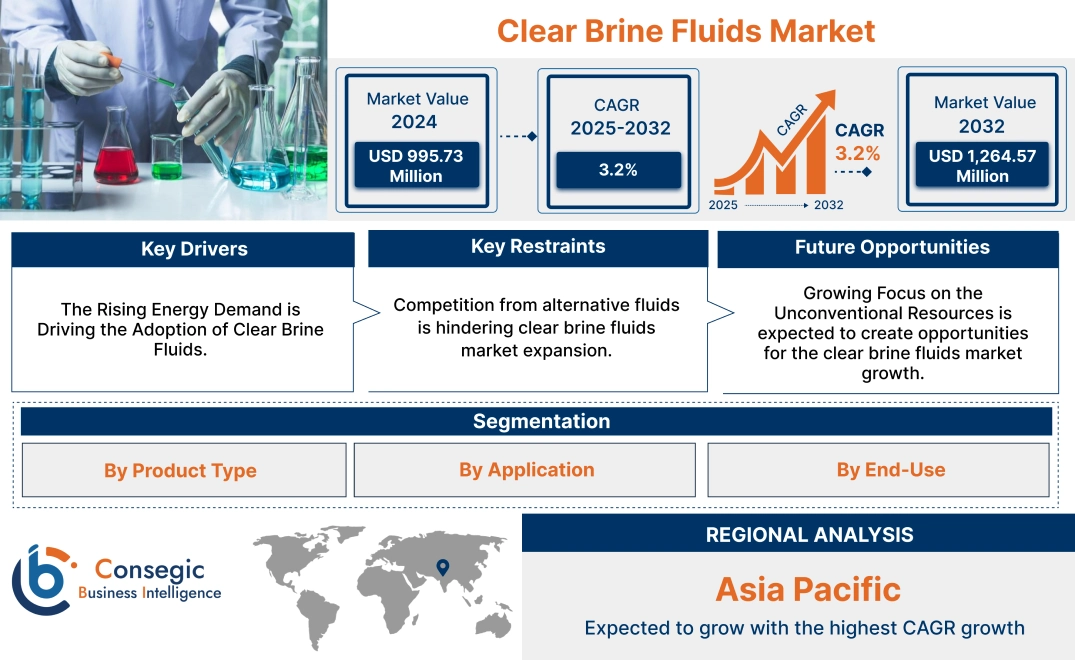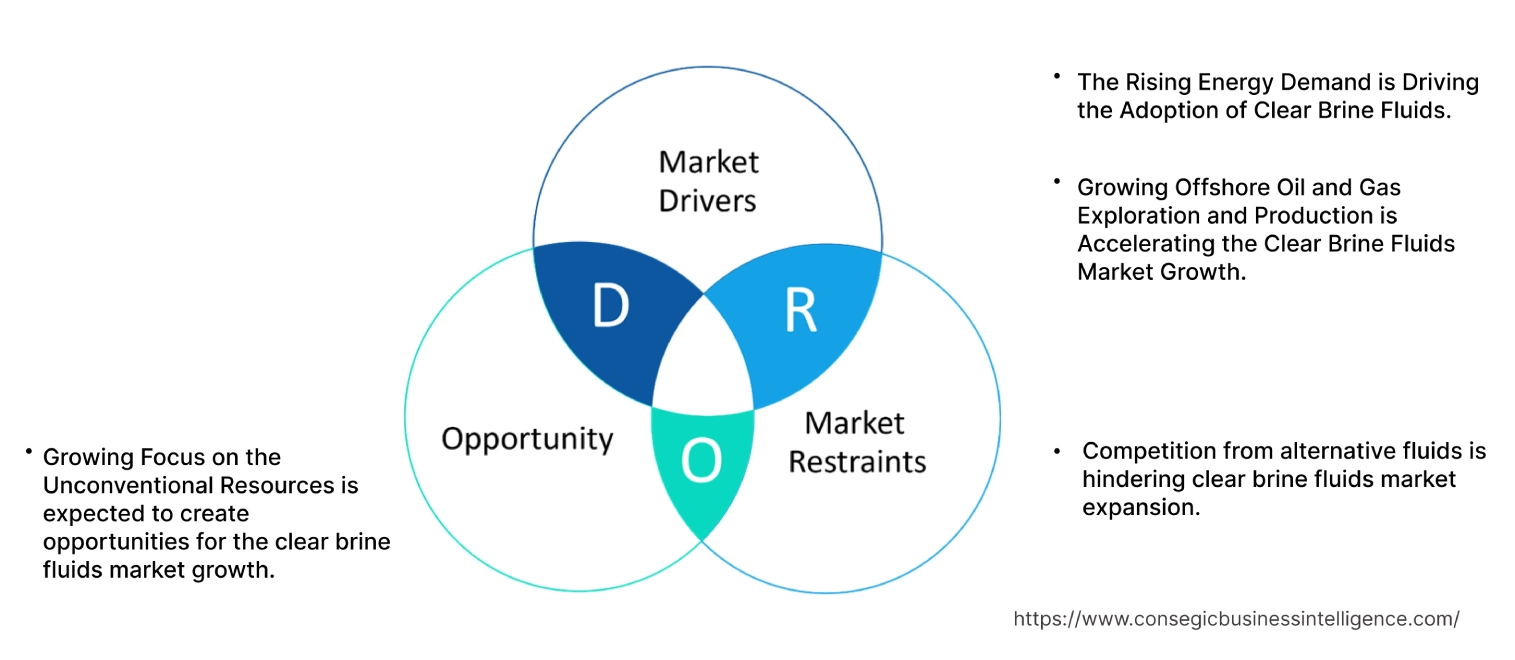Clear Brine Fluids Market Size:
Clear Brine Fluids Market size is growing with a CAGR of 3.2% during the forecast period (2025-2032), and the market is projected to be valued at USD 1,264.57 Million by 2032 from USD 995.73 Million in 2024.
Clear Brine Fluids Market Scope & Overview:
Clear brine fluids are highly saturated salt solutions employed in the oil and gas industry as drilling and well completion fluids. These solutions are composed of salts dissolved in water, such as ammonium chloride, calcium bromide, calcium chloride, sodium bromide, sodium chloride, sodium formate, potassium formate, cesium formate, and others. These fluids exhibit several key characteristics. They are adjusted to achieve high densities, crucial for controlling pressure during drilling and well completion operations. Some brine solutions, particularly those containing potassium formate, possess shale inhibition properties, preventing the swelling and instability of clay-rich formations. Additionally, they provide good lubrication, reducing friction and enhancing drilling efficiency. They also offer corrosion inhibition, safeguarding drilling equipment.
These fluids find diverse applications in the oil and gas sector. They serve as base fluids for drilling operations, providing density control, borehole stability, and lubrication. They are also employed in various completion operations, including casing and cementing, wellbore cleaning, and stimulation treatments. Furthermore, clear brines are utilized in workover operations to address issues such as wellbore integrity, production decline, and equipment failure.
Key advantages of these fluids include their versatility, allowing for formulation with different salts to achieve specific properties for varying well conditions. This creates them critical component in onshore and offshore oil & gas production activities. The growing global energy requirement, increasing offshore oil & gas production, and focus on unconventional energy resources are some of the prominent factors supporting the market trajectory.
Clear Brine Fluids Market Dynamics - (DRO) :
Key Drivers:
The Rising Energy Demand is Driving the Adoption of Clear Brine Fluids.
The rising global energy demand serves as a significant driver for the adoption of clear brine fluids. Access to affordable and reliable energy is fundamental to economic development. Economic growth leads to increased industrialization and urbanization. This translates to higher energy consumption across sectors like manufacturing, transportation, and construction.
- For instance, according to the data published by the India Brand Equity Foundation in August 2024, it is stated that India’s consumption of petroleum products stood at almost 4.44 million barrels per day (BPD) in FY23, up from 4.05 million BPD in FY22. India’s crude oil production stood at 2.69 MBPD during April-October 2023. Such high consumption of petroleum drives the requirement for clear brine fluids for production activities.
To meet this growing energy requirement, the oil and gas sector must increase production, necessitating increased drilling and completion activities. This increased activity translates to a higher demand for effective drilling fluids. Furthermore, as energy requirement rises, there's a growing emphasis on efficient and cost-effective oil and gas production. These fluids with their customizable properties and potential for improved drilling efficiency, help operators optimize well performance and reduce operational costs. As a result, the rising global energy requirement drives increased oil and gas production activities, ultimately fueling the requirement for effective and efficient drilling fluids like clear brines.
Growing Offshore Oil and Gas Exploration and Production is Accelerating the Clear Brine Fluids Market Growth.
The rise in offshore oil and gas exploration and production significantly drives the requirement for clear brine fluids. Offshore oil and gas production involves the extraction of hydrocarbons from beneath the ocean floor. This process utilizes specialized platforms constructed on the water's surface to drill wells, extract the oil and gas, process them, and subsequently transport them to shore via pipelines or tankers for further refinement and distribution. Essentially, it distinguishes itself from land-based extraction by targeting underwater reservoirs. The increasing global energy requirement and depleting onshore reserves are driving the rise in offshore crude and natural gas production activities.
- For instance, in March 2022, Shell Offshore Inc., a subsidiary of Shell plc, announced the start of production at PowerNap, a subsea development in the U.S. Gulf of Mexico with an estimated peak production of 20,000 barrels of oil equivalent per day (boe/d). The development of such offshore oil production creates the requirement for clear brine fluids.
Offshore drilling operations often encounter unique challenges such as high pressures, high temperatures, and corrosive environments, necessitating the use of specialized fluids. Brine fluids, with their customizable densities and enhanced corrosion inhibition capabilities, are well-suited to these demanding conditions. Furthermore, as the industry progresses toward offshore exploration and production, the need for fluids capable of withstanding extreme pressures and temperatures intensifies. This critical requirement aligns perfectly with the capabilities of these fluids. Overall, as per market analysis, the growing focus on offshore oil and gas production, driven by the need to access new reserves creates a strong requirement for specialized fluids like clear brines that effectively address the unique challenges of these operations.
Key Restraints:
Competition from alternative fluids is hindering clear brine fluids market expansion.
The wide availability of substitute options is significantly hindering the market. This factor is driven by the increasing preference for alternative materials including oil-based muds, water-based muds, synthetic base fluids, and specialized muds among others. Oil-based mud (OBM) is a drilling fluid composed of oil, water, emulsifiers, wetting agents, and gallants. Key advantages of OBM include its inherent lubricity, which contributes to maximizing drilling rates. It also exhibits enhanced shale inhibition properties. Furthermore, OBM demonstrates superior cleaning abilities with lower viscosity and possesses a high tolerance for heat without experiencing significant degradation.
Synthetic-based drilling mud (SBM), also known as low-toxicity oil-based mud, represents an inverted emulsion mud where synthetic oil serves as the external phase instead of traditional mineral oil. This compositional shift enhances the environmental acceptability of SBMs compared to conventional oil-based muds, particularly for offshore drilling. Water-based fluids (WBFs) are liquids that contain water as the primary component and are used in drilling operations. WBFs are commonly used because they are relatively inexpensive. These alternative fluids compete with clear brine fluids. Their availability puts pressure on its pricing and limits its market.
Future Opportunities :
Growing Focus on the Unconventional Resources is expected to create opportunities for the clear brine fluids market growth.
The increased focus on unconventional resources, such as shale gas and tight oil, is expected to create significant clear brine fluids market opportunities. As conventional oil and gas reserves decline, the need to explore and exploit alternative sources of hydrocarbons becomes increasingly critical. Unconventional resource extraction often involves complex wellbores, including horizontal drilling and multi-stage fracturing. Clear brine fluids, with their customizable densities and rheological properties, are well-suited to navigate these complex wellbores effectively, ensuring efficient drilling and completion operations.
Moreover, many unconventional reservoirs contain significant amounts of shale formations. Brine fluids, particularly those formulated with shale inhibitors like potassium formate, effectively prevent shale hydration, swelling, and dispersion, crucial for maintaining wellbore stability and minimizing formation damage. Unconventional resource development heavily relies on stimulation techniques like hydraulic fracturing, and these fluids serve as effective base fluids for these treatments, facilitating the efficient flow of proppants and maximizing well productivity. Furthermore, the growing investment in shale facilities is creating the requirement for these fluids.
- For instance, in March 2024, Argentina's national oil company YPF announced that it will invest USD 3 billion of a USD 5 billion capital spending plan in 2024 in shale, as it looks to generate more cash by exiting some major conventional fields.
As a result, the growing focus on unconventional resources presents significant clear brine fluids market opportunities to demonstrate their value as effective solutions for challenging drilling and completion operations.
Clear Brine Fluids Market Segmental Analysis :
By Product Type:
Based on product type, the market is categorized into ammonium chloride brine, calcium bromide brine, calcium chloride brine, sodium bromide brine, sodium chloride brines, sodium formate brine, potassium formate brine, cesium formate brine, and others.
Trends in the Product Type:
- Optimization of brine formulations to enhance their performance and environmental compatibility.
- Growing adoption of sodium formate brines as they are considered environmentally friendly and biodegradable, making them suitable for use in environmentally sensitive areas.
The sodium chloride brine segment accounted for the largest market share of 31.88% in 2024.
- Sodium chloride brine fluids are primarily composed of sodium chloride (NaCl) dissolved in water. The density of these fluids varies depending on the concentration of NaCl, with higher concentrations resulting in higher densities. They typically exhibit relatively low viscosity, facilitating efficient fluid circulation during drilling operations.
- Sodium chloride brine fluids are suitable for low-density operations such as shallow low-pressure wells that do not require the special inhibitive properties of calcium or potassium systems.
- This type of clear brine fluid is often chosen due to its cost-effectiveness, readily available, and low toxicity nature. Moreover, growing oil and gas production creates the requirement for cost-effective clear brine fluids such as sodium chloride brine.
- For instance, according to the data published by the U.S. Energy Information Administration in March 2024, the United States witnessed an increase in both oil and natural gas production in 2023. Data indicates that oil production averaged 13.3 million barrels per day, a notable rise from the 12.2 million barrels per day observed in December 2022. Similarly, natural gas production increased to an average of 128.8 billion cubic feet per day in 2023, compared to 121.1 billion cubic feet per day in December 2022. This surge in production was observed across various metrics, including well-level productivity for both oil and natural gas. Sodium chloride brine plays a crucial role in many of these oil and gas production activities as a common component of drilling fluids.
- Overall, as per analysis, sodium chloride brine's cost-effectiveness, availability, and suitability for low-pressure operations make it a widely used and essential component in the growing oil and gas sector.
The potassium formate segment is expected to grow at the fastest CAGR over the forecast period.
- Potassium formate brines excel as reservoir drilling fluids by effectively inhibiting shale hydration, migration, and swelling. This prevents formation damage and ensures hole stability.
- Additionally, saturated potassium formate exhibits high lubricity and provides excellent hydrate inhibition. Moreover, it is non-corrosive and considered more environmentally friendly than some traditional drilling fluids.
- Potassium formate brines find diverse applications across various well types. Their excellent shale inhibition properties make them particularly suitable for drilling in shale gas and oil formations, effectively preventing borehole instability. In high-pressure/high-temperature (HPHT) wells, these brines maintain their stability and performance under challenging downhole conditions. Due to their environmental compatibility, they are well-suited for subsea operations. Furthermore, potassium formate brines serve as effective completion fluids, facilitating production processes.
- Overall, as per analysis, the segment is projected to experience the fastest trajectory due to its increasing popularity in shale gas and tight oil operations.
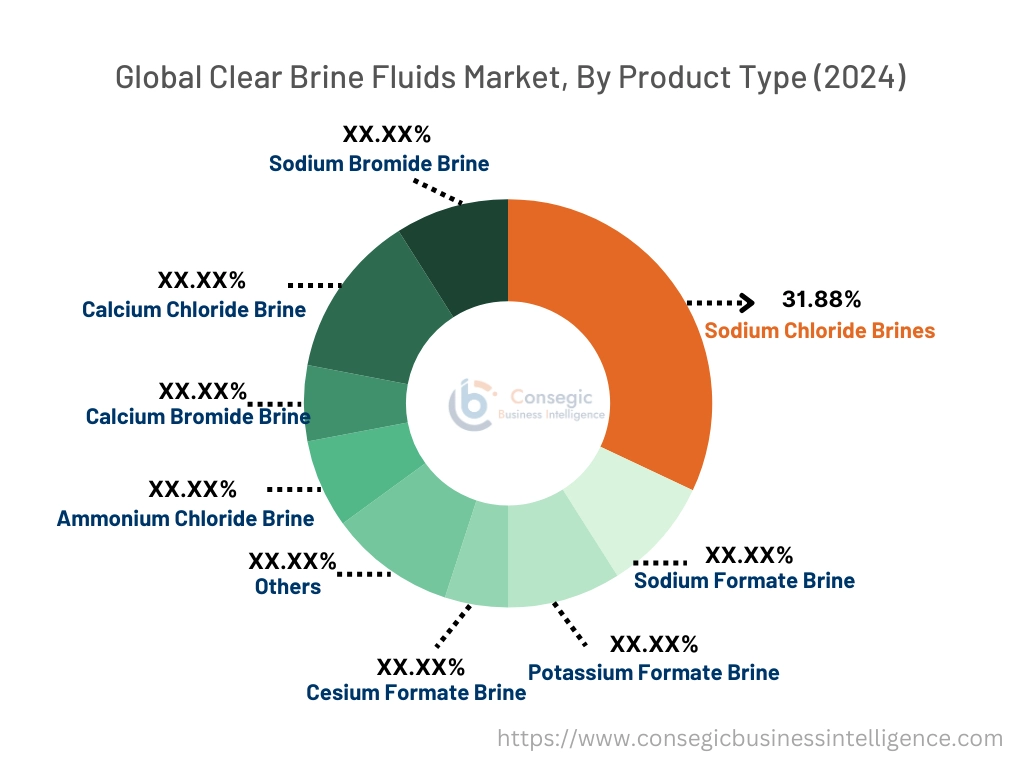
By Application:
Based on application, the market is categorized into good completion, workover operations, packer fluids, and others.
Trends in Application:
- Adoption ofcustomized clear brine fluid solutions tailored to specific workover challenges, such as dealing with high temperatures, high pressures, and challenging wellbore conditions.
- With the increasing focus on deepwater exploration and production, there's a growing requirement for high-density clear brine fluids for packer applications.
The well completion segment accounted for the largest market share in the year 2024.
- Well completion, a critical stage in oil and gas production involves preparing the well for production post-drilling. Clear brine fluids play a vital role in this process. They are utilized in displacing drilling fluids during casing and cementing operations, ensuring proper cement placement and preventing wellbore contamination.
- Additionally, clear brines effectively clean the wellbore of drilling fluids and cuttings, enhancing the efficiency of subsequent completion operations. These fluids also serve as base fluids for various stimulation treatments, such as hydraulic fracturing, to boost well productivity.
- Furthermore, clear brines are frequently employed in well-testing operations to assess well performance and reservoir characteristics.
- The ongoing exploration and development of new oil and gas reserves, particularly unconventional resources like shale, are driving an increase in drilling activity, consequently increasing the requirement for well completion fluids.
- Moreover, the oil and gas industry's increasing focus on maximizing well productivity and optimizing production from existing wells further emphasizes the crucial role of clear brine fluids in achieving these objectives.
The workover operations segment is expected to grow at the fastest CAGR over the forecast period.
- Clear brine fluids, essentially salt solutions in water, find significant applications in workover operations within the oil and gas sector. Workovers involve interventions in existing wells to address issues like declining production, equipment failures, or wellbore integrity problems. It also includes the maintenance and repair of existing wells.
- Workover operations are crucial for maintaining and improving production from existing wells, and the growing emphasis on EOR methods is driving the requirement for effective workover fluids. As oil and gas fields mature, aging infrastructure leads to a rise in workover operations to address issues such as wellbore integrity, production decline, and equipment failure.
- Moreover, advancements in workover technologies, including coiled tubing interventions and advanced stimulation methods, are creating the utilization of clear brine fluids.
- For instance, in July 2021, Drillmec announced the launch of the new ARS-225 mobile rig for drilling and workover operations in extreme conditions. The rig's ability to operate in extreme conditions, including potentially very cold temperatures, necessitates the use of drilling fluids such as clear brine fluids that withstand these harsh environments.
- Overall, these fluids play a vital role in workover operations, addressing critical issues such as declining production and equipment failures.
By End Use:
Based on end use, the market is bifurcated into onshore oil and gas production and offshore oil and gas production.
Trends in the End Use:
- The focus on unconventional resources like shale gas and tight oil is a trend creating the requirement for clear brine fluids with specialized properties like shale inhibition.
The onshore oil and gas production segment accounted for the largest market share in the year 2024.
- The onshore oil and gas production segment currently dominates the clear brine fluids market, holding the largest market share. This dominance stems from the significantly higher number of onshore wells compared to offshore wells within the global oil and gas sector, driving substantial requirements for clear brine fluids.
- They find diverse applications in onshore operations, including serving as base fluids for drilling operations, providing density control, borehole stability, and lubrication while minimizing formation damage and optimizing drilling efficiency.
- They are also employed in various completion operations such as casing and cementing, wellbore cleaning, and stimulation treatments such as hydraulic fracturing.
- Furthermore, they are utilized in workover operations to address issues like wellbore integrity, production decline, and equipment failure. They also serve as base fluids for various stimulation treatments, including hydraulic fracturing, acid washing, and sand control.
- Key drivers of trajectory in this segment include the presence of vast onshore oil and gas reserves globally, which fuels significant exploration and production activities, and advancements in drilling, completion, and stimulation technologies, creating ongoing requirements for clear brine fluid utilization.
The offshore oil and gas production segment is expected to grow at the fastest CAGR over the forecast period.
- The offshore oil and gas production segment is poised for the fastest growth within the clear brine fluids market demand during the forecast period. This trajectory is primarily driven by the ongoing exploration and development of offshore oil and gas fields, particularly in deepwater areas, which necessitates the use of specialized fluids like clear brines.
- These fluids find diverse applications in offshore operations, including serving as base fluids for drilling operations in challenging environments, providing density control, borehole stability, and lubrication while minimizing formation damage and optimizing drilling efficiency in deepwater and harsh conditions.
- Key drivers of growth in this segment include the development of offshore oil and gas fields.
- For instance, in November 2024, Exxon Mobil, one of the largest integrated fuels, lubricants, and chemical companies across the globe, announced to launch of offshore Cyprus gas drilling in 2025 as part of its natural gas exploration efforts. In offshore drilling, clear brines are frequently utilized as base fluids in drilling muds, offering essential functions such as density control, borehole stability, and lubrication. Moreover, they contribute to minimizing formation damage and optimizing drilling efficiency.
- Additionally, the increasing focus on environmental regulations in offshore operations is driving the requirement for environmentally friendly fluids like clear brines, which minimize environmental impact. Overall, as per the clear brine fluids market analysis, the offshore oil and gas production segment is expected to experience trends in the requirement for clear brines in the upcoming years due to increasing offshore exploration, and the requirement for environmentally friendly solutions for challenging deepwater environments.
Regional Analysis:
The regional segment includes North America, Europe, Asia Pacific, the Middle East and Africa, and Latin America.
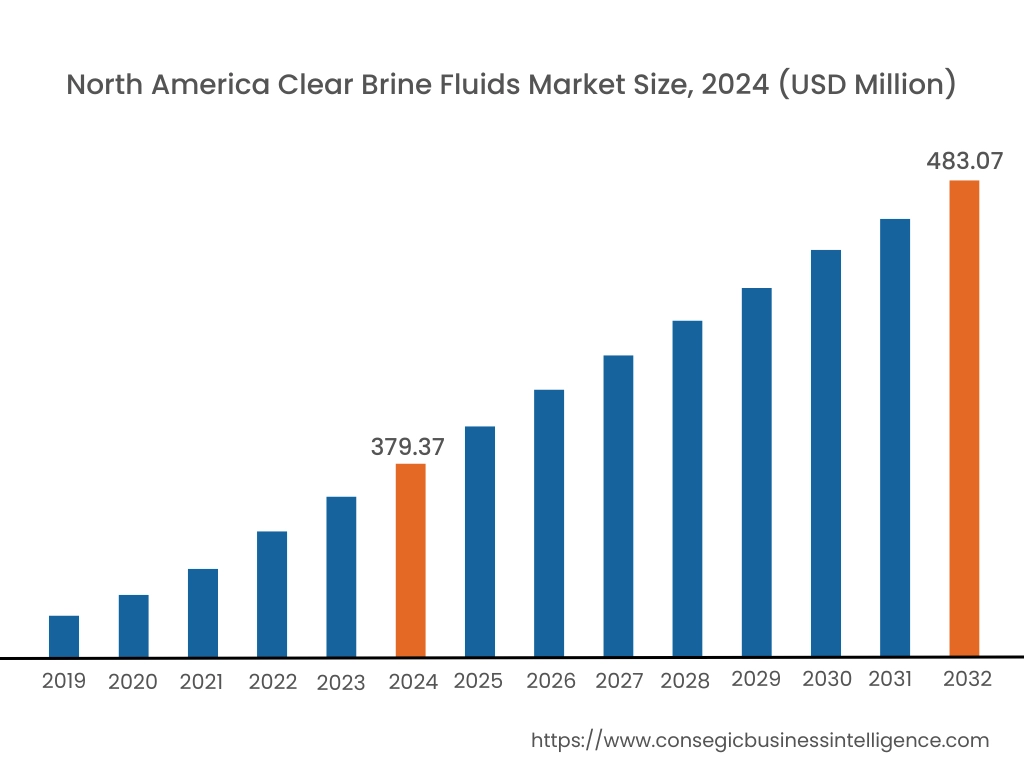
In 2024, North America accounted for the highest market share at 38.10% and was valued at USD 379.37 Million and is expected to reach USD 483.07 Million in 2032. In North America, the U.S. accounted for the highest market share of 72.88% during the base year of 2024. North America dominates the global clear brine fluids market, primarily due to the presence of established oil and gas industries in the United States and Canada. Particularly in the U.S. with its significant onshore reserves, including unconventional shale formations, and offshore exploration and production in the Gulf of Mexico creates the demand for clear fluid brines serving as drilling fluids, providing density control, borehole stability, and lubrication. The significant rise in oil and gas production across the region is contributing to the market trajectory.
- For instance, according to the data published by the U.S. Energy Information Administration in December 2023, U.S. dry natural gas production was about 36.35 trillion cubic feet (Tcf), in 2022 an average of about 96.60 billion cubic feet per day and an annual record high.
Additionally, the region serves as a hub for technological innovation in the oil and gas sector, with advancements in drilling, completion, and stimulation technologies, such as multi-stage fracturing and horizontal drilling, driving the requirement for effective fluids like clear brines. The oil and gas sector in North America is heavily focused on maximizing well productivity and optimizing production from existing wells, further emphasizing the crucial role of clear brine fluids in achieving these objectives. As a result, as per analysis, the combination of the aforementioned factors and trends is driving a substantial trajectory in the North American clear brine fluids market share.
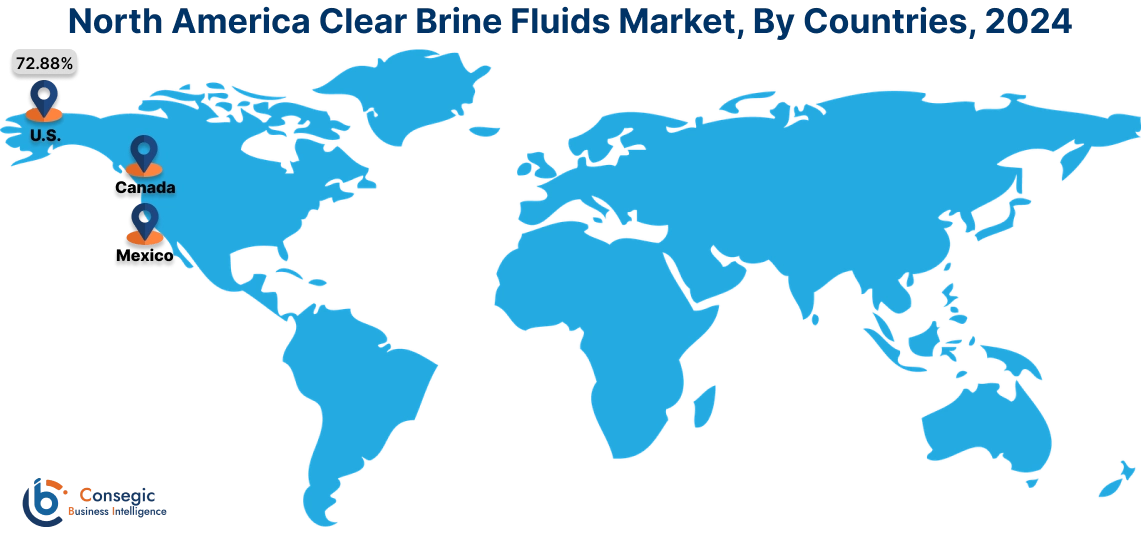
Asia Pacific is experiencing the fastest growth with a CAGR of 3.8% over the forecast period. The clear brine fluids market trend across the region is attributed to factors such as economic growth and industrialization across many Asian countries driving a surge in energy requirements, leading to increased oil and gas exploration and production activities. Countries like China, India, and Australia are emerging as major players in the global oil and gas sector, fueling the requirement for drilling and completion fluids. Moreover, government bodies across the region are actively promoting the development of their oil and gas sectors, creating a favorable environment for market trajectory.
Europe presents a significant contribution to the clear brine fluids market analysis. The European oil and gas sector market is mature, creating constant requirements for clear brine fluids in production activities. Additionally, the European region has some of the strictest environmental regulations in the world. This significantly influences the choice of drilling and completion fluids, driving the requirement for environmentally friendly options such as clear brine fluids. Europe has a significant presence in offshore oil and gas production, creating a requirement for specialized fluids suitable for challenging offshore environments. Overall, the European market is characterized by a focus on mature oil and gas fields and stringent environmental regulations. These factors, along with technological advancements and the ongoing requirement for effective and environmentally friendly fluids, are driving the trajectory of the market across Europe.
The Middle East and Africa (MEA) region is witnessing notable clear brine fluids market demand characterized by significant potential. This region boasts substantial oil and gas reserves, particularly in the Middle East, making it a key player in global energy production. Major oil-producing countries including Saudi Arabia, the United Arab Emirates, and Nigeria drive significant requirements for drilling and completion fluids. Continued exploration and development activities in both onshore and offshore areas are fueling the market trajectory. Moreover, many governments in the region are investing heavily in expanding oil and gas infrastructure and production capacity, creating a favorable environment for the clear brine fluids market trend.
Latin America is experiencing moderate growth in the clear brine fluids market share, with significant innovation potential. The Latin American clear brine fluids market expansion is experiencing a significant trajectory, driven by the presence of substantial oil and gas reserves, particularly in countries like Brazil. Additionally, government support for the oil and gas sector, including policies promoting exploration and production, and advancements in drilling, completion, and stimulation technologies are enabling the exploitation of more challenging reservoirs consequently creating the adoption of clear brine fluids as they find diverse applications, serving as base fluids for drilling operations, providing density control, borehole stability, and lubrication while minimizing formation damage and optimizing drilling efficiency.
Top Key Players and Market Share Insights:
The Clear Brine Fluids market is highly competitive with major players providing products to the national and international markets. Key players are adopting several strategies in research and development (R&D) and product innovation to hold a strong position in the global Clear Brine Fluids market. Key players in the Clear Brine Fluids industry include-
Recent Industry Developments :
Supply Expansion:
- In December 2021, ICL, a global specialty minerals company, announced a supply of clear brine fluids to the United Arab Emirates, directly from Israel for the first time.
Clear Brine Fluids Market Report Insights :
| Report Attributes | Report Details |
| Study Timeline | 2019-2032 |
| Market Size in 2032 | USD 1,264.57 Million |
| CAGR (2025-2032) | 3.2% |
| By Product Type |
|
| By Application |
|
| By End Use |
|
| By Region |
|
| Key Players |
|
| North America | U.S. Canada Mexico |
| Europe | U.K. Germany France Spain Italy Russia Benelux Rest of Europe |
| APAC | China South Korea Japan India Australia ASEAN Rest of Asia-Pacific |
| Middle East and Africa | GCC Turkey South Africa Rest of MEA |
| LATAM | Brazil Argentina Chile Rest of LATAM |
| Report Coverage |
|
Key Questions Answered in the Report
How big is the Clear Brine Fluids market? +
In 2024, the Clear Brine Fluids market is USD 995.73 Million.
Which is the fastest-growing region in the Clear Brine Fluids market? +
Asia Pacific is the fastest-growing region in the Clear Brine Fluids market.
What specific segmentation details are covered in the Clear Brine Fluids market? +
Product Type, Application, and End-use segmentation details are covered in the Clear Brine Fluids market.
Who are the major players in the Clear Brine Fluids market? +
LANXESS (Germany), ICL (Israel), and SLB (U.S.) are some of the major players in the market.
